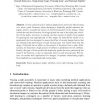Free Online Productivity Tools
i2Speak
i2Symbol
i2OCR
iTex2Img
iWeb2Print
iWeb2Shot
i2Type
iPdf2Split
iPdf2Merge
i2Bopomofo
i2Arabic
i2Style
i2Image
i2PDF
iLatex2Rtf
Sci2ools
HAID
2009
Springer
2009
Springer
Evaluating Factors that Influence Path Tracing with Passive Haptic Guidance
A very common task in medical applications and motor-skill training is to trace a path. However, when designing a haptically guided interface, designers need to consider the choice of several parameters in the design. These include the real-time function for bringing back the user to the right path, the effect of the path’s curvature on tracing, and the amount of haptic force needed for guiding the user appropriately. In this paper, we describe the results of an experiment that was designed to assess the effect of several design factors that can influence the performance of path tracing tasks. Our results show that the shape of the path has an effect on the amount of deviation from a path. Additionally, we found that a high amount of stiffness is preferred over low stiffness. Finally, the type of force profile that haptically guides the user, particularly the slope of the function, is also an important factor in path tracing tasks. We discuss our results with implications for designs...
| Added | 25 Jul 2010 |
| Updated | 25 Jul 2010 |
| Type | Conference |
| Year | 2009 |
| Where | HAID |
| Authors | Kurosh Zarei-nia, Xing-Dong Yang, Pourang Irani, Nariman Sepehri |
Comments (0)

